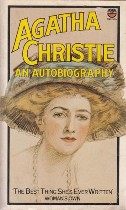 Agatha Christie •
Agatha Christie •
An Autobiography •
“What I want is to plunge my hand into a lucky dip and come up with a handful of assorted memories,” says Christie in her foreword. Unhampered by chronological constraints, her storytelling gifts soar here. Two events from a fascinating life stand out in memory: dinner with the queen at Buckingham Palace, and the purchase of her first car, a “grey, bottle-nosed Morris Cowley.” Now we know where Tuppence (The Secret Adversary) got her maiden name.
Christie aficionados will have fun tracing the origins of favorite books and characters. Grannie—who imagines the worst of everyone, and is generally right—foreshadows Jane Marple, while the mental patients who wander onto the lawn at Ashfield turn up, fictionalized, in Why Didn’t They Ask Evans? Victoria Jones (They Came to Baghdad) adopts Christie’s budgetary tactic of eating enormous fixed-price meals while traveling, with the same result: “feeling like an overstuffed boa constrictor.” Even a wallpaper of poppies and cornflowers resurfaces in Sleeping Murder. And when the author boards the Orient Express, you can almost see the wheels turning in her head as the locomotive steams its way across Europe.
Christie makes no mention of her famous disappearance, though she does describe the painful breakup of her first marriage. When she later receives a proposal from archaeologist Max Mallowan, a dear friend 13 years her junior, she decides the matter by consulting her “home oracle”—ten-year-old daughter Rosalind, who swiftly rules in Max’s favor.
The second marriage proves idyllic. Christie enthusiastically joins Mallowan’s expeditions to the Middle East (“How much I have loved that part of the world”), continuing to write her mysteries from a tent at the dig site. Here she is engrossed in penning Lord Egdware Dies when the workers unearth a Mesopotamian skeleton—and dub it Lord Edgware.







Your email address will not be published.